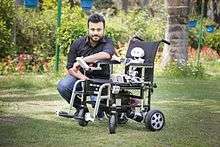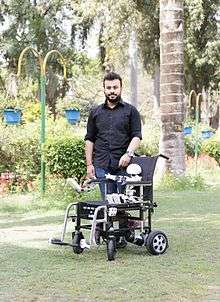Mind Controlled Wheelchair
| A-SET Mind Controlled Wheelchair | |
|---|---|
 Diwakar Vaish, the inventor of the wheelchair at the press launch, with his brainchild, Manav, on the wheelchair. | |
| Classification | Wheelchair |
| Industry | Various |
| Application | Conveyance, paralysis mobility |
| Fuel source | Electric |
| Powered | Yes |
| Self-propelled | Yes |
| Wheels | 4 |
| Inventor | Diwakar Vaish |
| Invented | 2016 |
The A-SET Mind Controlled Wheelchair is a mind-machine interfacing device that uses thought (neural impulses) to command the motorised wheelchair's motion. It has been designed by Diwakar Vaish, Head of Robotics and Research at A-SET Training & Research Institutes. It is the world's first in production neurally controlled wheelchair. The wheelchair is of great importance to patients suffering from Locked-in Syndrone (LIS) in which a patient is aware but cannot move or communicate verbally due to complete paralysis of nearly all voluntary muscles in the body except the eyes. It can also be used in case of Muscular Dystrophy, a disease that weakens the musculoskeletal system and hampers locomotion (walking or moving).The wheelchair is priced at nearly $ 3,000 USD ( 3,00,000 INR)
Description

The wheelchair functions using a Brain computer interface, an Electroencephalogram (EEG) which has to be worn on the user's forehead, detects neural impulses that reach the scalp allowing the micro-controller on board, to detect the user's thought process. To operate the wheelchair the user has to think of the direction of motion, this thought process would be detected by the dual onboard micro controllers which would process the data and in turn control the wheelchair's movement. The wheelchair comes standard with many different types of sensors,like temperature sensors, sound sensors and an array of distance sensors which detect any unevenness in the surface, the chair automatically avoids stairs and high incline, the wheelchair also has a safety switch which functions in a similar fashion to that of a fire button on the joystick of 4th or higher generation fighter jets. In case of a danger, for an emergency stop the user has to simply close his eyes quickly, the action is similar to that of a corneal reflex in a dangerous situation.
References
- http://indiatoday.intoday.in/story/no-buttons-no-joystick-please-welcome-the-worlds-first-mind-controlled-wheelchair-created-by-diwakar-vaish/1/622480.html
- http://tennews.in/introducing-worlds-first-mind-controlled-wheelchair/
- http://www.networkedindia.com/2016/03/18/the-worlds-first-mind-controlled-wheelchair/
- http://www.startupstalk.org/indian-develops-mind-controlled-wheelchair/
- https://www.youtube.com/watch?v=lhwpa2OdfOc
- https://www.inshorts.com/en/news/indian-develops-mindcontrolled-wheelchair-1458444319037
- http://www.scoopwhoop.com/This-Delhi-Man-Has-Designed-A-Wheelchair-That-Is-Controlled-By-The-Mind/